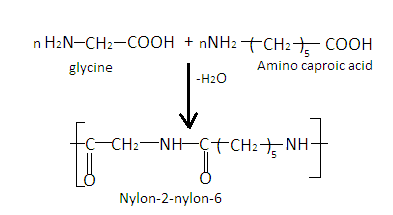Answer
36.9k+ views
Hint: Biodegradable polymers are polymers which can be degraded or broken down by other living organisms like bacteria so that the polymer does not cause any serious effect on the environment.
Step by Step Explanation: Nylon-$2$ -nylon-$6$ is a biodegradable polymer. It is a polyamide and is obtained by condensation of monomers glycine $\left( {{{\text{H}}_2}{\text{N - C}}{{\text{H}}_2}{\text{ - COOH}}} \right)$ and amino caproic acid $\left[ {{{\text{H}}_2}{\text{N}}{{\left( {{\text{C}}{{\text{H}}_2}} \right)}_5}{\text{COOH}}} \right]$ . When n numbers of glycine are condensed with n numbers of amino caproic acid, Nylon-$2$ -nylon-$6$ is obtained with the loss of water molecules. The reaction is as follows:

Nylon-$2$ -nylon-$6$ is an alternating polyamide copolymer as it is prepared from two monomers. It is used in-
- Synthesis of artificial fibers.
- As a thread in the bristles of a toothbrush.
- In making strings of musical instruments.
- As matrix material.
- In car components next to the engine due to heat resistance property.
Hence the correct answer is B.
Additional Information: Besides Nylon-$2$ -nylon-$6$, dextran and PHBV which are both polyesters are also bio-degradable polymers which can be degraded by bacteria in the environment. The characteristics of biodegradable polymers are-
1. They are inert and non-toxic
2. They have bio-compatibility.
3. They have permeability.
4. They have tensile strength and mechanical strength.
5. They have controlled the rate of degradation as they can be easily degraded within a suitable time –period.
Note: Biodegradable polymers have many uses in medical field-
1. They are used as orthopedic devices
2. They are used as implants and sutures.
3. They are also used as rug-release matrices.
Step by Step Explanation: Nylon-$2$ -nylon-$6$ is a biodegradable polymer. It is a polyamide and is obtained by condensation of monomers glycine $\left( {{{\text{H}}_2}{\text{N - C}}{{\text{H}}_2}{\text{ - COOH}}} \right)$ and amino caproic acid $\left[ {{{\text{H}}_2}{\text{N}}{{\left( {{\text{C}}{{\text{H}}_2}} \right)}_5}{\text{COOH}}} \right]$ . When n numbers of glycine are condensed with n numbers of amino caproic acid, Nylon-$2$ -nylon-$6$ is obtained with the loss of water molecules. The reaction is as follows:

Nylon-$2$ -nylon-$6$ is an alternating polyamide copolymer as it is prepared from two monomers. It is used in-
- Synthesis of artificial fibers.
- As a thread in the bristles of a toothbrush.
- In making strings of musical instruments.
- As matrix material.
- In car components next to the engine due to heat resistance property.
Hence the correct answer is B.
Additional Information: Besides Nylon-$2$ -nylon-$6$, dextran and PHBV which are both polyesters are also bio-degradable polymers which can be degraded by bacteria in the environment. The characteristics of biodegradable polymers are-
1. They are inert and non-toxic
2. They have bio-compatibility.
3. They have permeability.
4. They have tensile strength and mechanical strength.
5. They have controlled the rate of degradation as they can be easily degraded within a suitable time –period.
Note: Biodegradable polymers have many uses in medical field-
1. They are used as orthopedic devices
2. They are used as implants and sutures.
3. They are also used as rug-release matrices.
Recently Updated Pages
If a wire of resistance R is stretched to double of class 12 physics JEE_Main

The path difference between two waves for constructive class 11 physics JEE_MAIN

What is the difference between solvation and hydra class 11 chemistry JEE_Main

IfFxdfrac1x2intlimits4xleft 4t22Ft rightdt then F4-class-12-maths-JEE_Main

Sodium chloride is purified by passing hydrogen chloride class 11 chemistry JEE_Main

Consider the following oxyanions PO43P2O62SO42MnO4CrO4S2O52S2O72 class 11 chemistry JEE_Main

Other Pages
The mole fraction of the solute in a 1 molal aqueous class 11 chemistry JEE_Main

If a wire of resistance R is stretched to double of class 12 physics JEE_Main

Lowering in vapour pressure is highest for A 02 m urea class 11 chemistry JEE_Main

An electric bulb has a power of 500W Express it in class 11 physics JEE_Main

Which of the following Compounds does not exhibit tautomerism class 11 chemistry JEE_Main

The ratio of speed of sound in Hydrogen to that in class 11 physics JEE_MAIN



